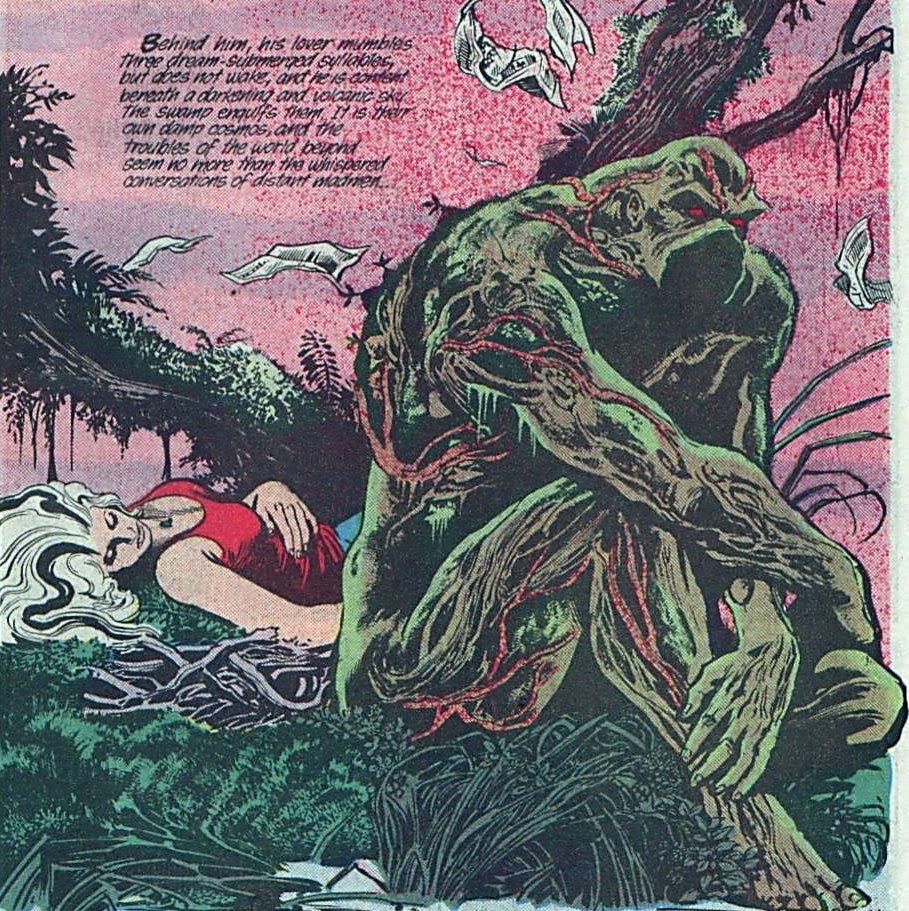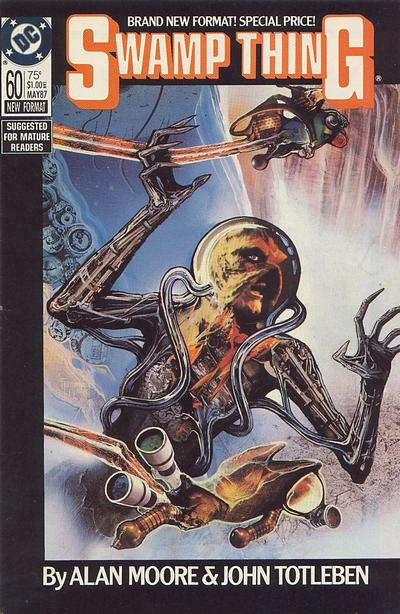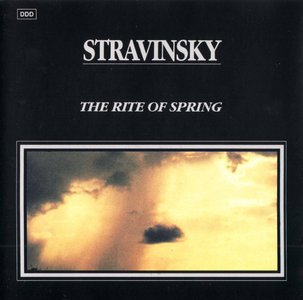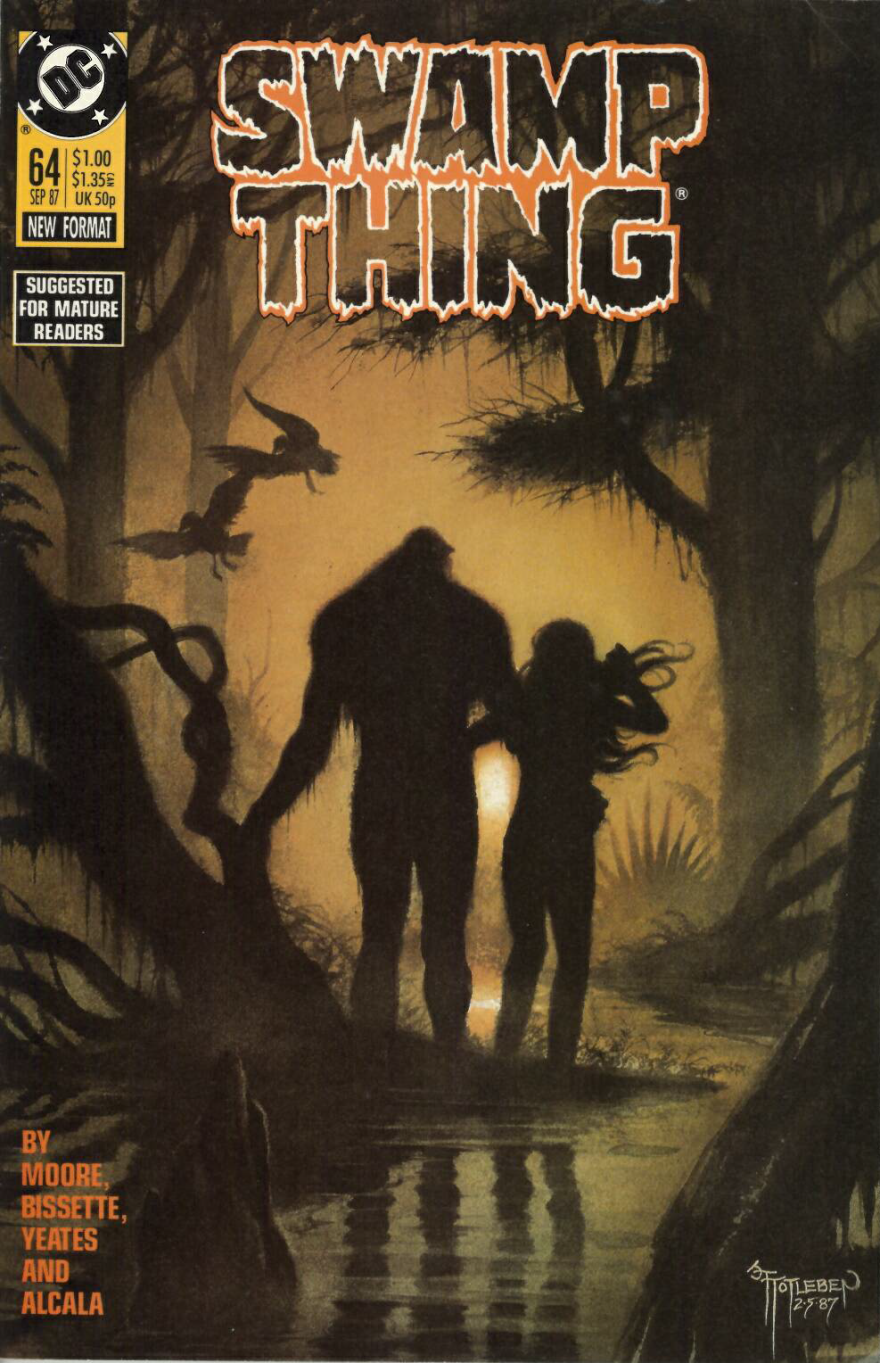Welcome to the Binge Project series! These Binge Projects will feature me reading or watching an entire run of comics, books, TV shows, or other media in rapid order, then writing expansively about the experience. This installment takes an in-depth look at Alan Moore’s Swamp Thing. Moore’s run covered issues 20-64 and Annual #2, originally running from January 1984 to September 1987. Click here for Part 1. Click here for Part 2. Click here for the Intermission. Click here for Part 3.
[Optional soundtrack to this Binge Project.]
Part 4: The Rite of Spring (conclusion)
How do you know you’ve stayed somewhere too long?
The conclusion to “American Gothic,” issue #50, was titled “The End.” You could argue it was a perfect time for the end of Moore’s time on SWAMP THING. But Moore’s final issue would come more than a year later, in #64.
In between, Moore gives us a lesson on power, and takes us into outerspace. For me, this time period marked a relative decline in Moore’s run.
It starts with a three-issue arc following up on “American Gothic,” featuring Swamp Thing taking on Gotham City and even Batman. This was another story I appreciated more on this reread than the first time through. Originally, I was a little off-put by how quickly Swamp Thing seemed to unlearn his lessons from the preceding epic.
Now, I think that story is a big part of what makes Swamp Thing seem so human. Sure, he goes too far, but that’s life. We can grow and learn and develop, but real life isn’t epiphanies and permanent change. Real life is sometimes backsliding and losing control; it’s sometimes being overwhelmed by what you want and taking the wrong approach. And as much as Moore sometimes made Swamp Thing a symbol or a larger-than-life figure, he ultimately wanted to ground him in real life. And if that means adding tragic flaw to the character equation, then that’s what Moore did.
And then … 10 issues of space adventure.
But let’s back up and finally talk about the art during Moore’s SWAMP THING run.
The fact that the art discussion is buried this far in the Project is not indicative of its quality or importance, but just the fact that I’m not good at writing about art expansively. Despite the fact that comics are a visual medium, I’ve always been more attracted to the quality of writing than of the art, as much as I appreciate the latter.
And it’s hard not to appreciate the art on SWAMP THING. The majority of the run is illustrated by the penciller/inker team of Stephen Bissette and John Totleben. Bissette and Totleben imbue the book with a moody style that was a perfect match for Moore’s horror stories. They put a strong emphasis on heavy lines, dark tones, and shadows that feel almost oppressive at times. Bissette loved big splash pages with collages of images that set his issues apart from the rest of the run. Bissette’s time as the regular penciller ended with #50, though he wrote a fill-in issue later that he’d co-plotted with Moore, and returned to draw a few pages of #64, Moore’s finale. Totleben returned to handle all the art for issue #60, a highly experimental issue that was the weirdest of the run.
There were several issues of strong fill-in art throughout the run from contributors like Stan Woch and Rick Veitch. After Bissette and Totleben left, Veitch took over as the regular penciller, inked by Alfredo Alcala. After Moore left, Veitch would take over writing the book, as well. Veitch was a highly capable artist himself, but I found myself missing Bissette’s collages.
A final word of praise must go to Tatjana Wood, the colorist. I rarely single out a colorist’s work unless there’s a problem, and I admit I tend to take their work for granted. But Wood achieved perhaps the greatest coloring masterpiece I’ll ever see, in issue #56, the melancholy “My Blue Heaven.” The issue featured a world where everything is blue. Rather than feeling confined by that color pallet, the issue explodes with vibrancy thanks to Wood. Wood fills that world with endless shades of blue that let the reader still feel the contrast and keeps everything standing out like it should. It was an impressive feat in a challenging situation.
Unfortunately, it was also the first space episode, and as I mentioned, this was a time of decline for the run, in my eyes. I read somewhere that Moore moved to space stories largely because Veitch was more interested in drawing science fiction stories than the horror tales that dominated Bissette’s tenure, and Moore was an accommodating collaborator. I have no idea if that’s true, but whatever the reason, I think it was a mistake.
Swamp Thing felt out of place among the stars. The character was intended to feel out of place there, but it was the stories themselves that felt out of place in that book. So much of what gave the book its eerie power was the darkness Moore explored. For most of his final 10 issues, he lost that power. He tried to blend sci-fi and horror in one issue that featured Swamp Thing on a world of sentient plants; it was an enjoyable issue, but still a notch below the heights Moore was reaching regularly for most of his run.
That how I would describe most of the space issues: enjoyable, but just not the same. I found particular enjoyment from a two-parter on Rann, largely because I have an affinity for the underused Adam Strange, and the dynamics between Rann and the Hawkpeople of Thanagar were good story fodder. Still, though, the best content during this time was usually showing Abby back on Earth, and the ways she struggled and grew without Swamp Thing. On the other end of the spectrum was issue #60, the aforementioned deeply experimental issue with computer-aided art and a story that was almost incomprehensible, albeit in a weirdly beautiful way. Even upon rereading that one, I still don’t feel like I truly “get” it on its deepest level.
But Moore was always ready to take chances and shoot for ambitious stories, willing to accept that they might not all land. The truth is that he was so damn good that even his so-called failures aren’t really bad. But when his successes were some of the greatest ever accomplished, the contrast isn’t kind to his lesser offerings.
Which brings me, at last, to the optional soundtrack I’ve had at the beginnings of the posts for this Project: Igor Stravinsky’s “The Rite of Spring,” for which this final section is also named. Although that title is also the name of one of Moore’s most famous issues (#34, the union of Swamp Thing and Abby, which I covered in Part 2), I chose this accompaniment before remembering that coincidence.
Stravinsky, a Russian composer, wrote that music for a 1913 ballet of the same name. The story of the ballet revolves around a pagan ritual in which a young woman is sacrificed to the god of spring; she literally dances herself to death so that spring may begin. When the ballet opened, it caused such fervor that there were reportedly riots at its Paris premiere. It’s a work of furious passion that it evokes the same in its audience.
When researching the piece, my favorite comment was that it demonstrated Stravinsky’s “abhorrence of everything for which music has stood these many centuries … all human endeavour and progress are being swept aside to make room for hideous sounds.” Obviously, this was intended as an insult, but I think it can be viewed as more than just that. The work does display a willful dissonance that pounds away at you. But I think there’s greatness in that willingness to sweep aside centuries of history to try something so boldly unique.
And really, that’s Moore’s SWAMP THING. For decades, people had said what comics could and couldn’t be, and Alan Moore swept all that aside to surpass the limitations of the medium and break incredible new ground. Some of his later issues on the title fell short, in the same way that some of the notes in “The Rite of Spring” are more jarring than pleasing. You could give into the temptation to try to separate and categorize issues or sections as good or bad, but it’s best to look at it all as one unified whole, and accept the imperfections that are unavoidable when chasing something that will move you so violently and wondrously.
Moore returned to earth for one last piece of horror in issue #63. Issue #64, Moore’s last on the title, was a beautiful tribute to all he had done with his two main characters and how far the book had come under him.
Veitch would take over the writing after Moore, and some fans have high views of his run. In recent years, DC has been pushing Swamp Thing again as an important character in the center of the DCU. Swamp Thing is a unique, versatile character who can add an element to DC’s supernatural world, so I think it’s a worthwhile effort.
But there’s a part of me that struggles to feel the same enthusiasm for idea of the character as written by anyone else. I loved SWAMP THING more than I can adequately convey, but my love for this run was less about Swamp Thing as a character, and more about Swamp Thing as imagined by Moore. I fully acknowledge that this is narrow-minded. The nature of comics is that each writer gets to put his own spin on a character; today’s creators are certainly free to interpret Swamp Thing much like Moore did, or reinvent him as they see fit (Moore’s run was a massive departure from what came before him, after all). I don’t even doubt that their stories are or can be good.
But when I think of Swamp Thing, I think of the perfect way Moore ended his run. No popular comic book character’s work is ever done; if the character has enough of a following, then it’s only a matter of time before he or she is dragged back to the thick of things, forced to contend again with whatever struggles and obstacles a new creator can imagine.
Maybe I long for that one happy ending that lasts. That character who can retreat to his swamp with his one true love and remain there in peace, safe forever more from our hopes or fears or expectations, our bleeding hearts and prying eyes. The way Alan Moore left these characters is the way I want to imagine them forever.
.
This concludes Binge Project: Alan Moore’s SWAMP THING. Thanks for reading!






